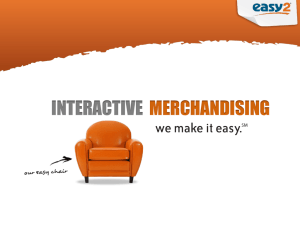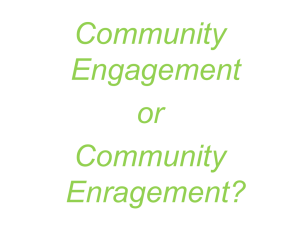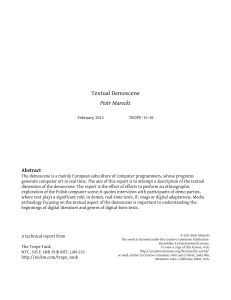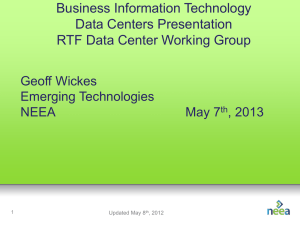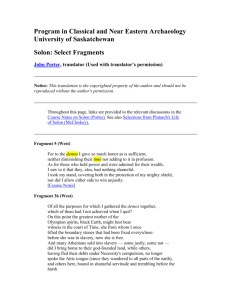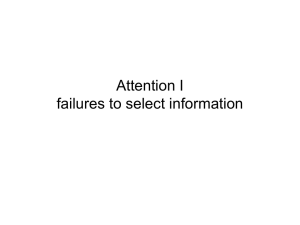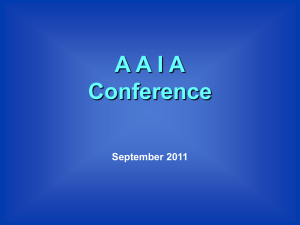here - Science Made Simple
advertisement
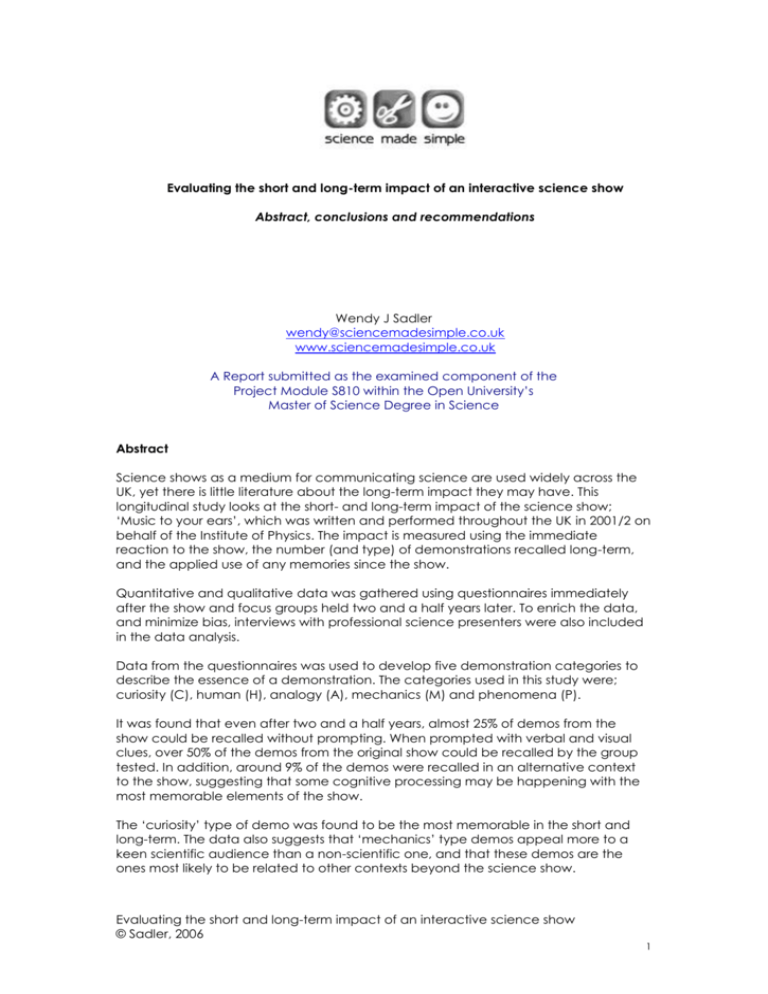
Evaluating the short and long-term impact of an interactive science show Abstract, conclusions and recommendations Wendy J Sadler wendy@sciencemadesimple.co.uk www.sciencemadesimple.co.uk A Report submitted as the examined component of the Project Module S810 within the Open University’s Master of Science Degree in Science Abstract Science shows as a medium for communicating science are used widely across the UK, yet there is little literature about the long-term impact they may have. This longitudinal study looks at the short- and long-term impact of the science show; ‘Music to your ears’, which was written and performed throughout the UK in 2001/2 on behalf of the Institute of Physics. The impact is measured using the immediate reaction to the show, the number (and type) of demonstrations recalled long-term, and the applied use of any memories since the show. Quantitative and qualitative data was gathered using questionnaires immediately after the show and focus groups held two and a half years later. To enrich the data, and minimize bias, interviews with professional science presenters were also included in the data analysis. Data from the questionnaires was used to develop five demonstration categories to describe the essence of a demonstration. The categories used in this study were; curiosity (C), human (H), analogy (A), mechanics (M) and phenomena (P). It was found that even after two and a half years, almost 25% of demos from the show could be recalled without prompting. When prompted with verbal and visual clues, over 50% of the demos from the original show could be recalled by the group tested. In addition, around 9% of the demos were recalled in an alternative context to the show, suggesting that some cognitive processing may be happening with the most memorable elements of the show. The ‘curiosity’ type of demo was found to be the most memorable in the short and long-term. The data also suggests that ‘mechanics’ type demos appeal more to a keen scientific audience than a non-scientific one, and that these demos are the ones most likely to be related to other contexts beyond the science show. Evaluating the short and long-term impact of an interactive science show © Sadler, 2006 1 Conclusions and recommendations Summary of conclusions The research has met the objectives stated at the beginning of the report. Because of careful preparation for this study 3 years ago I was able to contact students a long period after the science show. This has provided a unique opportunity to look at the long-term impact of such an event in a way that is not often done by other researchers due to time restrictions and the logistics of getting hold of audiences after the event. I was able to establish some short-term quantitative and qualitative data, conduct two focus groups to establish long-term impact and devise a set of demo categories to help analyse the data, and this was enriched by triangulating the data by interviewing professional presenters. In summary the research found that: The short term reaction to this show was 100% positive and was rated as Excellent or Good by all who completed the questionnaire Both age groups who took part in the questionnaire rated the show slightly higher on an entertaining scale than on an educational scale The older groups tended to rate the science show as slightly less entertaining than the younger groups. This is likely to be because the presenting style used with younger students is focused more on entertainment, and also because younger students have lower expectations about what is classed as ‘entertaining’ Without any verbal or visual prompts, members of the focus group managed to recall around 25% of the demonstrations used in the show after a period of two and a half years had elapsed. With some visual prompts the groups managed to recall over 50% of the demos used There is evidence that members of the audience have made related links to things they saw in the show in other contexts. Around 9% of the memories from the show in the long-term related to this kind of recall The ‘curiosity’ type of demo (bizarre, novel, unexpected, counter-intuitive, challenging) consistently comes out as the demo type that has the biggest impact – in that it is most memorable, most commonly referred to in conversation and most frequently cited by professional presenters when talking about the type of demos they like to use This research suggests an analysis procedure using the CHAMP demo categories. These five categories are Curiosity, Human, Analogy, Mechanics and Phenomena. Some demos have more than one category element, but all will fit somewhere within these definitions, and most have a clear primary category which can be defined as the reason the demo has been selected at that point in the show. This study has been incredibly useful for my own professional development as an informal science learning practitioner. After ten years of actively writing and presenting shows, there has never before been the time or opportunity to review what is being done beyond a ‘snapshot’ of evaluation immediately after the show. I Evaluating the short and long-term impact of an interactive science show © Sadler, 2006 2 have been surprised by some of the results (that ‘phenomena’ demos have fairly low impact) and other data has affirmed my instincts about what works particularly well. There was a higher than expected amount of recall from the focus groups even two and a half years on from the show (and even straight after an A-level exam!). This is quite inspirational, and it backs up the suggestion by Burns that people do recall demos some time after a show is over (Burns, 2003). One of the most exciting things for me was to hear that the students had made links between things they saw in the show and science in other contexts. There is sometimes criticism that events like science shows and festivals have a short-hit lifetime that is quickly forgotten. If this research suggests that even one or two things remain with someone long enough for them to process the memory and use it in an applied situation then this is a real achievement for informal science learning. The development of the demo categories and the data about which ones are most memorable has been an incredibly useful exercise. I intend to continue using the categories informally to ensure a good balance of demo types are included in the shows I develop for the future. Guidelines for best practice Based on this research it is recommended that science show professionals ensure a mixture of the CHAMP demo categories within their presentations as there is evidence to suggest different types of audience respond to different categories of demonstration. However some generalisations can be made: Curiosity type demos seem to be universally popular regardless of the audience and have a high impact rate for short and long-term recall Human angle demos are also highly memorable (though not quite as much as ‘curiosity’) so they also have a fairly high impact Mechanics type demos are more popular with audiences that are already interested in science. Mechanics demos are also the type that are most likely to help people relate the show to other contexts Analogy and Phenomena demos are useful educational tools, but they tend to have less short and long-term impact. In addition, the data suggests that short-term impact is likely to be similar to that which is remembered in the long-term. This means that when there is a lack of resources for longitudinal studies, it may be possible to extrapolate from the shortterm impact to make a hypothesis about the kind of things that are likely to be remembered over a longer period of time. As pointed out in the literature review, however, presenters must always be aware that demonstrations have the ability to confuse as well as inform, so it is important to think carefully about the structure and any unnecessary ‘noise’ when trying to get a message across (Roth et al., 1997). In an attempt to get this message out to practitioners I will be submitting papers based on this research to the publications which are used by science communicators. These will include the BIG (British Interactive Group) Newsletter, ECSITE-UK newsletter, Physics Education and hopefully the Public Understanding of Science and Interdisciplinary Science Review Journals. In addition I will propose further sessions on this subject area at professional conferences over the next 12 months. Evaluating the short and long-term impact of an interactive science show © Sadler, 2006 3 Opportunities for further research The scale of this project has not allowed full exploration of all the elements of the research data. The author would encourage others to use this model as a basis for further exploration. Possible projects that would help build on this knowledge include: Applying these demo categories to a variety of shows and a variety of different aged audiences to see if different category types really do tend to appeal to different ages Trying short, medium and long-term research to see how the memories change over time Conduct a similar longitudinal study but try and include some data about attitudes rather than just the memories. If the affective domain is where the science show aims to make a difference, then this needs to be measured in some way Appendix Demonstration Categories by characteristic Catego ry code C Category name Curiosity H Human A Analogy M Mechanics P Phenomena Definition The audience…? Something weird, a piece of equipment never seen before, something counter-intuitive, a challenge to the audience A volunteer is used, all of the audience take part in an experiment, something personal is learnt, something funny happens to volunteer A visual representation of something that is usually invisible, using body language to draw a mental picture, using models How things work, taking things apart and seeing what is inside, how the science is applied in real life things, how to make simple things, in general applied science – technology A chance to see a scientific phenomena happening live, may use equipment not readily available, not necessarily weird, illustrates the basic science using a demonstration rather than words Are surprised Interacts Understands Contextualises Experiences Evaluating the short and long-term impact of an interactive science show © Sadler, 2006 4
